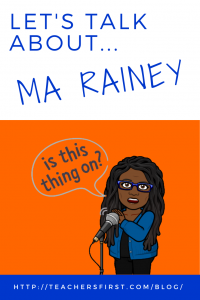June is African American Music Month. Well-meaning teachers may take this as an opportunity to introduce a lesson about African American music. However, without context or connection to the curriculum, the class might fall flat and not engage students as intended. I want to suggest a more culturally responsive approach. Reading Teach Boldly for the TeachersFirst winter book study this year reminded me that there are many ways that we can repurpose the time we have with our students by structuring our instruction differently. What if – instead of teaching a lesson on African American music – we asked students to explain what music in the US would be like if no one had ever heard Ma Rainey sing?
Using a technology-integrated approach, we could set up several documents and experiences to scaffold student exploration. First, start with the end in mind. How do you expect students to answer the question? What do you expect them to create? Will there be a single product or multiple products? How will you assess student work? Make a rubric and review it with your students so they understand your expectations.
Next, create a playlist outlining the path students should take to answer the question. Include both mini-lessons that students should participate in and activities they should complete. Need help learning how to create a playlist? Check out this OK2Ask session.
If they haven’t already, students will need to learn about research and evaluating resources. You can create those lessons on your own or use Ever-Fi (reviewed here) or Checkology (reviewed here). They will also need to understand something about resource curation as they build knowledge about who Ma Rainey was. For younger students, you might want to create a Multimedia Text Set that gives them the starting place for their research and allows them to assume that you have chosen good resources for them to investigate.
Offer choice by creating a choice board with ways that students can consolidate their newfound knowledge of the “mother of the blues.” Options can be as simple as creating a timeline of her life or recording an “interview” with her. Character maps, character charts, and identity iceberg graphic organizers can help students move past simple reading comprehension to a deeper understanding of the person Ma Rainey was, her influence on the music of the time, and interpersonal relationships of note. Older students or those who are more tech-savvy could create a Fakebook profile (reviewed here), a historical GoFundMe account, or present her life as the newest Netflix serial.
As students plan their final product, have them use a persuasion map to organize their thoughts. For example, did Ma Rainey play a formative role in music here in the US? What evidence did they uncover that supports their assertion? From this, they can write an essay, create a simple video slideshow, or participate in a video-based debate.
Do you have plans to incorporate African American music month into your instruction? Let us know what they are by placing a comment below.


